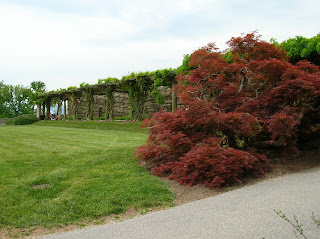Next thing I knew, I was driving on the First Bunker Road, past some orange groves that my dad used to tend, past Oak Hill, toward Limestone. (Don't bother, you may not find all of these names on the map.) I saw the sign for "Solomon's Castle" and made the spontaneous decision that I would pay a visit. On toward Lily, and then the drive toward the castle. Though I'd heard of this attraction for years, I'd never been there. I believe that Howard Solomon first began building his remote Florida paradise in 1972, after I'd already left Arcadia for college. On subsequent visits home, and even during a brief period after college graduation when I returned to Arcadia to teach, there always seemed to be something more pressing than going out to visit what I'd assumed to be just another tacky tourist trap. This day, I hadn't passed another car on the road for several miles (only great trucks hauling late-season oranges and watermelons) so I was very surprised to find a dozen or so cars in the parking lot for the castle.
And after paying my admission I was again surprised, in realizing that Solomon's Castle is far from being a tacky tourist trap. It is (a) a monument to recycling, the epitome of the old saying that "One man's trash is another man's treasure;" (b) a fascinating glimpse into the mind of a true artist; (c) proof that "If you build it, they will come;" (d) a lot of fun; (e) all of the above. It is difficult to describe in words what you'll find, but here's a link to the website: Solomon's Castle
I enjoyed seeing old metal coat hangers made into a zoo that included a giraffe and an elephant. There were numerous sculptures made out of discarded oil drums. There were montages paying tribute to masters such as Picasso and Matisse. And lots of jokes and really bad puns about the different works of art that revealed a delightful wit. (Even the restrooms -- sporting an old "Rooms To Go" sign -- were labeled with humor.)
The tour of the "castle" is but a small part of the experience. If you're hungry, you can get a really delicious home-made meal or scrumptious dessert in the "Boat in the Moat." There's shopping, of course, for both Howard's works as well as some carefully selected items that echo a nature theme. I chose to wander one of the trails leading down to Horse Creek, and marveled at how long it'd been since I'd felt good ol' Florida scrub sand between my toes. Heck, with advance reservations, you can spend the night in the castle, or in the luxurious B&B that's on the grounds!
I'm not sure this event qualifies as "serendipitous." Perhaps it lacks the connection to divine providence that a strict definition of serendipity requires. However, the experience refreshed me, and reinforced for me the notion that there are treasures all around, sometimes hidden under our noses, sometimes (as in my case) for years ... and maybe it takes a little inconvenience or some similarly not-altogether-pleasant thing to nudge us in their direction. Yes, I'm disappointed that our van is still, as of this writing, waiting for the mechanic, and no one seems to know just when it'll be set right. (Maggie, by the way, is right as rain!) But it turned out to be a fun day, an enlightening experience ... and quite an inspiration.
I enjoyed seeing old metal coat hangers made into a zoo that included a giraffe and an elephant. There were numerous sculptures made out of discarded oil drums. There were montages paying tribute to masters such as Picasso and Matisse. And lots of jokes and really bad puns about the different works of art that revealed a delightful wit. (Even the restrooms -- sporting an old "Rooms To Go" sign -- were labeled with humor.)
The tour of the "castle" is but a small part of the experience. If you're hungry, you can get a really delicious home-made meal or scrumptious dessert in the "Boat in the Moat." There's shopping, of course, for both Howard's works as well as some carefully selected items that echo a nature theme. I chose to wander one of the trails leading down to Horse Creek, and marveled at how long it'd been since I'd felt good ol' Florida scrub sand between my toes. Heck, with advance reservations, you can spend the night in the castle, or in the luxurious B&B that's on the grounds!
I'm not sure this event qualifies as "serendipitous." Perhaps it lacks the connection to divine providence that a strict definition of serendipity requires. However, the experience refreshed me, and reinforced for me the notion that there are treasures all around, sometimes hidden under our noses, sometimes (as in my case) for years ... and maybe it takes a little inconvenience or some similarly not-altogether-pleasant thing to nudge us in their direction. Yes, I'm disappointed that our van is still, as of this writing, waiting for the mechanic, and no one seems to know just when it'll be set right. (Maggie, by the way, is right as rain!) But it turned out to be a fun day, an enlightening experience ... and quite an inspiration.


















